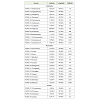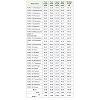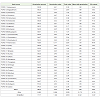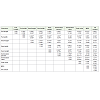Research Article
Variability Studies for Seed and Seedling Traits in Undi (Calophyllum Inophyllum L.) from Different Zoneso South India
Palanikumaran B*, Parthiban KT, Sekar I, Umarani R, and Amirtham D
Corresponding author: Dr. Palanikumaran B, Forest College and Research Institute, Mettupalayam - 641 301, Tamil Nadu, India,; E-mail: kumaranbass@gmail.com
Forest College and Research Institute, Mettupalayam - 641 301, Tamil Nadu, India
Citation: Palanikumaran B, Parthiban KT, Sekar I, Umarani R, Amirtham D. Variability Studies for Seed and Seedling Traits in Undi (Calophyllum Inophyllum L.) from Different Zoneso South India. J Plant Sci Res. 2015;2(2): 124.
Copyright © 2015 Palanikumaran B et al. This is an open access article distributed under the Creative Commons Attribution License, which permits unrestricted use, distribution, and reproduction in any medium, provided the original work is properly cited.
Journal of Plant Science & Research | ISSN: 2349-2805 | Volume: 2, Issue: 2
Submission: 09/06/2015; Accepted: 05/07/2015; Published: 11/07/2015
Abstract
The present investigation was carried out at Forest College and Research Institute, Mettupalayam, Tamil Nadu to identify the best half sibs of Calophyllum inophyllum across its natural distribution of south India for further collection of seeds for afforestation and breeding purpose. Seeds collected from Western Ghats of Karnataka were superior compared to seeds from other parts in all the traits considered for the study. These seed sources can be further screened for tree improvement traits considering their immense value in yielding biodiesel. Regarding genotypic correlation Pod length, Pod width, Seed length, seed width, Seed weight, Germination percent, Germination value, Peak value and Mean daily germination showed positive significant correlation with oil content. But phenotypic correlation Pod length, Germination value, Peak value showed positive but significant correlation with oil content. Pod width, seed length, seed width, Seed weight, Germination percent, Mean daily germination, showed positive but non-significant correlation with oil content.
Keywords: Calophyllum inophyllum; Variability; Seed source; Seed length; Seed width
Introduction
Calophyllum inophyllum is a multipurpose tree belonging to thefamily Clusiaceae, commonly known as Mangos teen. It grows in areaswith an annual rain of 1000-5000 mm at altitudes from 0 to200 m.Calophyllum inophyllum is allow-branching and slow-growing treewith two distinct flowering periods of late spring and late autumn.But sometimes its flowering may occur throughout the year.
Calophyllum inophyllum grows best in sandy, well drained soils. However it tolerates clays, calcareous, and rocky soils. The treesupports a dense canopy of glossy, elliptical, shiny and tough leaves,fragrant white flowers, and large round nuts. Its size typically rangesbetween 8 and 20m (25-65ft) tall at maturity, sometimes reachingupto35m (115ft). The growth rate of the tree is 1 m (3.3ft) in heightper year on good sites. Its leaves are heavy and glossy,10-20 cm (4-8 inch) long and 6-9 cm (2.4-3.6 inch) wide, light green when youngand dark green when older. The fruit is reported to be pinkish-greenat first. However, it turns later to be bright green and when ripe,itturns dark grey- brown and wrinkled. The tree yield is 100-200 fruits/kg. In each fruit, one large brown seed 2-4 cm (0.8-1.6in.) India meteris found. The trees yield 3000-10,000 seeds/tree/season. The seed issurrounded by a shell and a thin layer of pulp of 3-5 mm. Calophylluminophyllum Oil is non-edible and dark green. Traditionally, its oil hasbeen used as a medicine, soap, lamp oil, hair grease and cosmetic indifferent parts of the world. Recently, Calophyllum inophyllum hasbeen proposed as a source of biodiesel.
Materials and Methods
The present study was under taken during the year 2014-15 atForest College and Research Institute (Mettupalayam), Coimbatore. Which is situated at 1119’N latitude and 7756’E longitude and analtitude of 350 m above MSL. The average annual rainfall is 945 mm,most of which is received between June to September. The temperaturevaries from 15 to 34.9 C. The extensive survey was under taken acrossthree different states and one union territory of India. A distance ofat least 200 m was maintained between two trees and at least 25 kmbetween two seed sources. The individual tree was identified based ontheir phenotypical characteristics and the individual tree identity wasalso maintained. Seeds were extracted from 100 pods after sun dryingfor 10 days for assessment of seed characteristics. Further same seedswere used for assessing germination and seedling characters. Seed parameters such as seed length, seed width, seed thickness, seedvolume and 100 seed weight were recorded for each seed source.
The experiment was laid out in completely randomized designwith five replications of 100 seeds each. The seeds were sown in thestandard nursery bed and regular watering was done. Observations ondaily germination were recorded up to 31 days from date of sowing.Germination percentage, peak value, mean daily germination,germination rate and germination value were recorded for eachseed source. Data collected was analysed statistically using Mstatc program Table 1.
Number of seeds germinated
Germination per cent = --- X 100
Number of seeds sown
Germination value (GV) = PV X MDG
Where, PV- Peak Value of germination.
MDG- Mean Daily Germination
Total germination per cent
Peak Value = -------------------------------------Total number of days Final germination per cent
Mean Daily Germination = -----------------------------------------The number of days that took to reach Peak Germination
Estimation of oil content using Soxhlet method
For estimating oil, the seeds were depulped, the kernels driedat 50C for 16 hrs and allowed to cool in a desiccator. Five gramsof seeds were pulverized to a fine powder in a porcelain mortar. Ground samples were placed in a filter paper and fastened in sucha way to prevent escape of the meal and then carefully transferredto an extraction thimble. The thimble was then placed in a Soxhletextractor to which sufficient quantity of solvent petroleum ether (40 -60°C.) was added and heated until eleven siphonings were completed.The oil content was recorded by evaporating the petroleum etherat 60°C. The entire extraction process was carried out in Soxhletextractor according to AOAC (1970). The percentage of oil contentwas then calculated by using the formula.
Oil weight (g)Oil per cent = ----------------------------- x 100Sample weight (g)
Results and Discussion
Analysis of variance (ANOVA) revealed that the results werestatistically significant for all the germination attributes (Table 2). Overall germination per cent was on/or above the 50 per cent.Maximum germination per cent was found in Honnavara region (78.00%), owing to higher mean daily germination (1.79), Germinationvalue (5.11) and peak value of germination (3.06). It was followed byNagapattinam region (68.00 %) and Pechiparai region (81.67 %) seedsources. Whereas, minimum germination per cent was recorded onDharapuram region (64.00 %). The size and shape of seeds is variabledepending on the structure and form of the ovary and environmentalconditions under which plant is growing. It is evident from theresult that seeds from Honnavara region was found to be superiorwith respect to germination percentage. This is in line with studymade by Dwivedi [1] in Azadirachta indica and Devagiri et al. [2] inDalbergia sissoo. They found that the variation observed in the seedcharacters may be attributed to adverse environment and differences in their distribution range this in turn affect the germination of seeds.Seedlings of Honnavara region higher oil content (64.6 %). It wasfollowed by Nagapattinam (58.30%) and Pechiparai region (57.30 %).
Data from the Table 3 revealed that seed traits for all seed sourcesshowed significant differences. The seeds collected from Honnavararegion were longest, thickest and had higher mass as well as seedvolume compared to all other seed sources. Seed length amongstvarious seed sources varied from 17.71 mm to 27.15 mm, seed widthfrom 12.44 mm to 23.50 mm.
Pod length and pod width varied from 25.07 mm to 39.57 mmand 22.06 mm to 34.44 mm respectively. The 100 seed weight rangedbetween 68.08 g to 133.30 g. These variations may be due to the factthat, this species grows over a wide range of climatic conditions aswell as soil types and altitudes. Similar findings were revealed bySudhir Kumar [3] in Jatropha curcas and Vasanth Reddy et al. [4-7]in Pongamia pinnata.
Correlation Studies
Genotypic correlation
Pod length (0.853), Pod width (0.389), Seed length (0.408), seedwidth (0.639) Seed weight (0.373), Germination percent (2.793),Germination value (1.217), Peak value (1.336) and Mean dailygermination (0.639) showed positive significant correlation with oilcontent (Table 4).
Table 4: Genotypic and phenotypic correlation of seed and seedling attributes of Calophyllum inophyllum in South India.
Phenotypic correlation
Pod length (0.370), Germination value (0.318), Peak value (0.339)showed positive but significant correlation with oil content. Pod width(0.150), seed length (0.171), seed width (0.195), Seed weight (0.187),Germination percent (0.269), Mean daily germination (0.060), showed positive but non-significant correlation with oil content(Table 5 and 6). A highly significant and positive correlation existedbetween Pod length (0.370), Germination value (0.318), Peak value(0.339). Significant correlation among various seed germination andseedling traits suggests that test weight may prove to be importantcriteria in selection of geographic seed sources for raising stock forbulk commercial plantations.
This study identifies two best sources for Calophyllum inophyllumL based upon seed and seedling traits for those places of Honnavaraand Nagergoil which were sampled. On a short term basis, breedingzones may be set up in these environmentally homogeneous areas.However, this may be preliminary as only seedling traits have beenconsidered. Hence, seed source screening provides a great opportunityto the tree breeder to screen and capture natural variation for successof afforestation, besides providing information on the raw materialfor breeding and evolving improved planting stock within a seedsource.
Acknowledgments
Acknowledgments are due to department of tree breeding, forest college and research institute (FC&RI) and UGC - Government ofIndia funded by the whole project. Gratitude is expressed towards myguide and all the scientist for their kind and support. Thanks are alsodue UGC- RGNF for the project for further execution.
References
- Dwivedi AP (1993) National level of Neem Seed source trials at Jodhpur. SystEcol Contrib 5: 20-34.
- Devagiri GM, Dhiman RC, Thapiyal RC, Nautiyal, S (1998) Seed sourcevariation in pod and seed traits of Dalbergia sissoo. Ann For 6: 148 -155.
- Sudhir Kumar (2003) Effect of seed size on germination and seedling traitsof Jatropha curcas. Nation. Workshop Jatropha Other Perennial Oil SeedSpecies, 5th to 8th Aug. 2003, Bharathiya Agro-Industries Federation of India(BAIF), Pune pp: 5-7.
- Vasanth Reddy KN, Pradeep Kumar H, Siddraju CM, Rajesh P, MadiwalarSL, et al. (2007) Seed source variation for seed and seedling traits inPongamia pinnata (L.) Pierre; An important biofuel yielding tree species. MyFor 43: 61-68.
- Geethanjali K, Balasubramanian A, Paramathma M (2003) Seed technologicalstudies in Jatropha Curcus. Nation. Workshop Jatropha Other Perennial OilSeed Species, 5th to 8th Aug. Bharathiya Agro-Industries Federation of India(BAIF), Pune pp: 31-33.
- Jenner VG, Dasthgir MG, Prathiban KT, Sudhagar JR (2003) Variabilitystudies in seed and seedling attributes in Mahauva(Madhuca latifolia). IndianFor 129: 509-516.
- Sniezko RA, Stewart HTL (1989) Range-wide provenance variation in growthand nutrition of Acacia albida seedlings propagated in Zimbabwe. For EcolMgmt 27: 179 -197.




